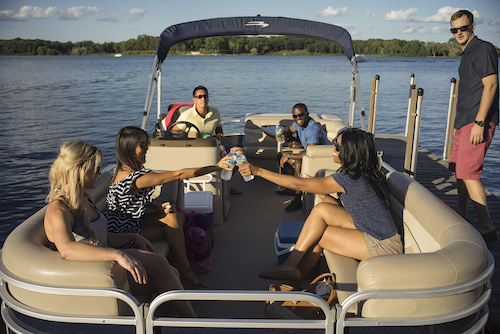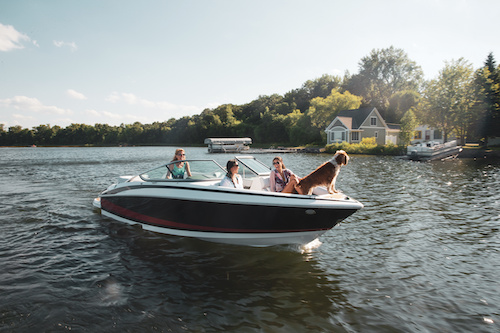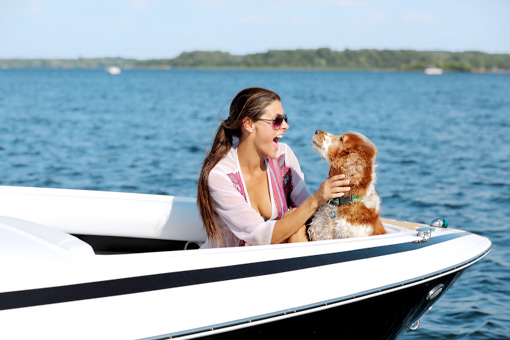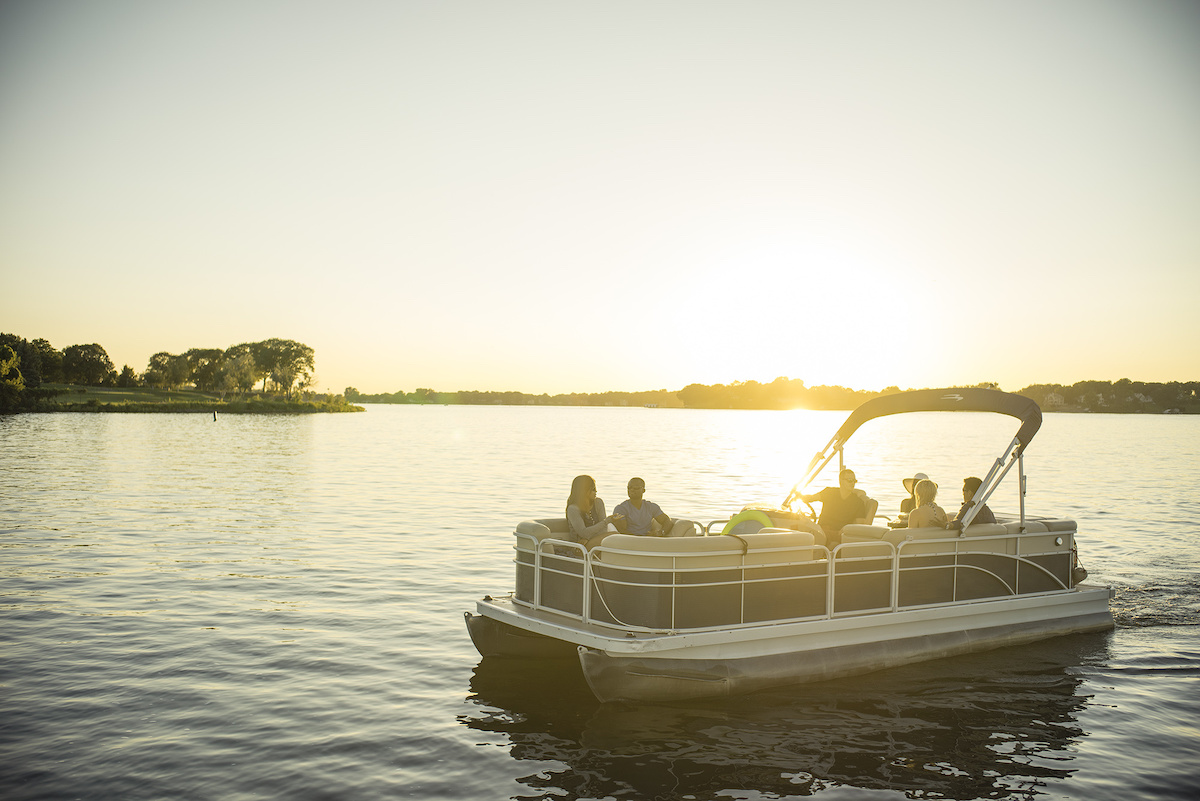As you browse for a boat, pontoon boats and bowriders are two popular options you might come across. Since the ideal choice depends on your particular budget, boating habits, and preferences, it's important to understand how these vessels compare.
Fortunately, we've done the heavy lifting for you. This pontoon vs. bowrider guide can help you weigh the pros and cons of each option and make the most informed investment for your unique situation.
What Is the Difference Between a Pontoon and a Bowrider?
This design creates a spacious deck and excellent stability on calm waters, making pontoons ideal for relaxing, day cruising, and carrying groups comfortably.
Bowriders feature a V-shaped hull, an open bow seating area, and either outboard or sterndrive power. Their hull design lets them reach higher speeds, handle sharp turns, and perform well in rougher conditions, making bowriders a better choice for high-performance boating.
Is a Pontoon Cheaper or a Bowrider?
Pontoons are generally more affordable than bowriders due to their simpler design and lighter engines. Typical price ranges include:
Pontoon Boats:
- Entry-level models: ~$16,000
- High-end luxury models: Up to ~$150,000
- More affordable overall because of modular construction and lower engine power
Bowriders:
- Most models: $20,000–$50,000
- High-performance or premium models: Can exceed $500,000
Overall, pontoons cost less on average, while bowriders have a wider price range due to performance-focused designs.
Pontoon Boat vs Bowrider: Which Is Better for Social Gatherings?
Pontoon Boats:
Best for hosting groups thanks to their:
- Wide, open decks
- Flexible seating layouts
- Built-in tables and sunshades
- Entertainment features
- Ample storage
- These features give passengers room to move around, making pontoons ideal for entertaining.
Bowriders:
- Can fit smaller groups
- Offer less deck space than pontoons
- Better suited for outings focused on speed and performance rather than socializing
How Do Pontoon Boats Handle Rough Waters?
Pontoon Boats:
- Very stable on calm rivers and lakes
- Flat hulls make them less capable in rough or choppy water
- Best for smooth-water cruising and relaxed outings
Bowriders:
- V-shaped hull cuts through waves for a smoother ride
- Higher performance makes them better suited for rougher conditions
- A safer choice for open water or areas with frequent chop
Choose a pontoon for calm-water comfort and a bowrider for handling waves and tougher conditions.
Is a Pontoon or Bowrider Better for Watersports?
If watersports are a priority, a bowrider is the better choice. Its design offers:
- A V-shaped hull for smoother, more controlled handling
- Higher-performing outboard or sterndrive engines
- The speed and agility needed for activities like water skiing, tubing, and wakeboarding
Pontoons can tow for casual fun, but they aren't ideal for high-energy sports. They're better suited for:
- Relaxing cruising
- Calm-water outings
- Boating trips that prioritize comfort over performance
For thrill-seeking watersports, bowriders deliver the power and maneuverability you need.
What Engines Do Pontoon and Bowrider Boats Use?
A boat's engine directly affects its performance, so it's helpful to know how the two compare.
Pontoon Boats:
- Typically powered by outboard engines
- Easier to maintain
- Provide enough power for day cruising and light recreational use
Bowriders:
- May use outboards or sterndrive engines
- Sterndrives generally offer:
- Higher top speeds
- Better maneuverability
- Improved performance for watersports and high-energy activities
In short, pontoons focus on simple, reliable cruising power, while bowriders offer stronger performance options.
How Do Amenities and Storage Compare Between Pontoon and Bowrider Boats?
Pontoon boats generally offer more comfort features and storage than bowriders. Many pontoons include:
- Plush seating
- Built-in tables and cup holders
- Sunshades
- Non-slip flooring
- Wet bars
- Swim ladders
- Generous storage for gear and equipment
Bowriders are more performance-focused and include fewer amenities. Depending on the model, you may find:
- A tow bar for watersports
- A walk-through windshield
- Basic storage compartments
While both offer storage, pontoons provide significantly more room for gear and onboard essentials.
Pontoon or Bowrider: Which One Should You Choose?
Whether you'd be better off with a pontoon or a bowrider depends on your boating habits and what matters most to you.
A pontoon boat is ideal if you prioritize relaxation and lounging on calm waters, especially if you want plenty of room for your loved ones.
A bowrider, on the other hand, is the better option if you like watersports and/or need a vessel that performs well in choppy waters.
Should I Consider Other Types of Boats?
Yes. Pontoons and bowriders are versatile, but many other boat types may fit your needs.
Great Options for Anglers:
- Center consoles: Durable, spacious, and ideal for serious fishing
- Aluminum fishing boats: Lightweight and perfect for rivers and small lakes
If You Want Space and Performance:
- Deck boats: Offer pontoon-like space with bowrider-style handling
For High-Speed or High-Thrill Boating:
- Speedboats: Built for fast acceleration and sporty handling
- Catamarans: Stable, fast, and capable in rougher water
Small, Affordable Alternatives:
- Kayaks
- Canoes
- Rowboats
- Inflatable boats
Exploring these options helps you match the vessel to your budget, boating style, and preferred water conditions.
Bowrider vs. Pontoon: The Choice is Yours
Just like all boats, pontoons, and bowriders have their own strengths and weaknesses. While pontoon boats offer ample space for storage and passengers, they lack sufficient power for watersports or other activities that require higher performance.
Bowriders, however, are powerful enough to handle the roughest waters and water sports, but are limited in space. Once you figure out your priorities, you'll find it easier to find the right vessel for your unique situation.
Pontoon vs. Bowrider Q&A
Q: Pontoon vs. bowrider—how do you choose the right boat?
A: Pick a pontoon if you want maximum deck space, comfort, and affordable cruising on calm waters. Choose a bowrider if you need speed, sharp handling, and better performance in rougher conditions or for watersports.
Q: Which boat is better for socializing?
A: Pontoon boats. Their wide, open layouts, flexible seating, and comfort features make them ideal for larger groups and onboard entertaining.
Q: Which handles rough water better?
A: Bowriders. Their V-shaped hulls and higher-powered engines provide a smoother, safer ride in choppy conditions than flat-deck pontoons.
Q: Which is better for watersports?
A: Bowriders offer the speed, agility, and tow-friendly power needed for skiing, tubing, and wakeboarding. Pontoons can tow lightly but aren't ideal for high-energy sports.
Q: Should I consider other boat types?
A: Yes. Center consoles, aluminum fishing boats, deck boats, speedboats, and even kayaks or inflatables may better fit your needs, depending on your budget, watersports goals, and where you boat.
Read Next: Pontoon vs. Deck Boat
Originally published in May 2020. Updated in December 2025.



